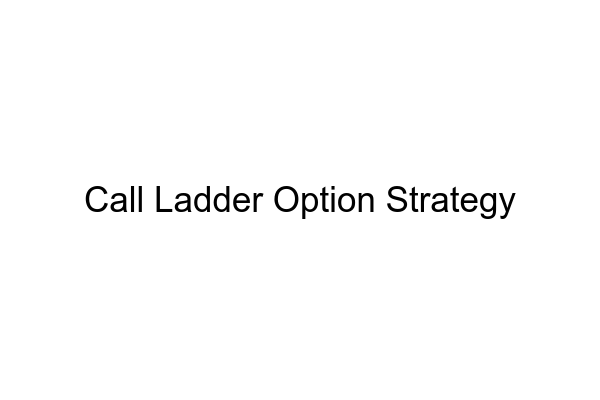Call Ladder Option Strategy

What are the characteristics of this option strategy?
The ladder option strategy is a bullish/bearish options trading strategy that allows traders to take advantage of price movement as per market outlook while hedging the downward risk. The strategy requires an equal number of call options to be held at various strike prices with same expiry dates. Traders use this strategy in an effort to generate income, manage risk, and capture price movement.
Is this a bullish, bearish or neutral strategy?
The ladder option strategy can be created in bullish/bearish way as per trader’s outlook. It is executed by buying/selling OTM, ATM, ITM call options at different strike prices, in order to profit from either direction the underlying asset moves.
Is this a beginner or an advanced option strategy?
The ladder option strategy is classified as an advanced strategy due to its complexity. A trader must have an intimate understanding of the factors underlying an asset’s volatility in order to effectively employ the strategy.
In what situation will I use this strategy?
The ladder option strategy is best used when the trader is expecting a significant amount of price movement in the underlying asset. Traders who are expecting significant upward/downward movement or volatility in the underlying asset may use this strategy to take advantage of both the up and down changes in price.
Where does this strategy typically fall in the range of risk-reward and probability of profit?
The ladder option strategy is generally classified as low-risk to medium-risk, depending on the specific parameters of a trader’s individual trades. The probability of profitability from this strategy can vary from moderate to high, depending on the trader’s ability to accurately identify volatility in the underlying asset.
How is this strategy affected by the greeks?
The delta, gamma and vega of a ladder option strategy are all important factors to consider when implementing the strategy. By managing the delta, gamma and vega of the options, a trader can effectively manage the risk of their position and maximize the chance of profitability.
In what volatility regime (i.e. VIX level) would this strategy be optimal?
The ladder strategy is ideally suited when the VIX index is at medium to high levels. By buying calls and puts with various expirations, a trader can take advantage of the high volatility in the underlying asset to generate a profit.
How do I adjust this strategy when the trade goes against me?
When the trade goes against a trader using the ladder option strategy, they can adjust the strategy by adjusting the delta, gamma and vega of the options in their portfolio. This can be done by either closing existing positions and opening new positions, or by buying and selling options to adjust the delta, gamma, and vega of their existing positions.
Where does this strategy typically fall in the range of commissions and fees?
The ladder option strategy generally carries a moderate to high cost of commissions and fees, depending on the specific broker used. Brokers typically charge commissions based on the number of trades placed, and also on the premiums paid for the option contracts.
Is this a good option income strategy?
Yes, the ladder option strategy can be a good option income strategy. By taking advantage of the underlying price movements in the market, traders can generate income while managing the risk associated with volatility.
How do I know when to exit this strategy?
When trading the ladder option strategy, traders should exit their trades on a predetermined set of conditions. Exiting trades should occur when the underlying asset is not expected to cross $240-$260 range, when the option contracts are close to expiration, or when the trader no longer wishes to maintain their position in the market.
How will market makers respond to this trade being opened?
When a trader opens a ladder option trade, market makers will respond to the trade by buying and selling option contracts to ensure that the bids and offers are in equilibrium. The market makers will typically adjust their offers to offset the exposures that the trader has in the market.
What is an example (with calculations) of this strategy?
For example, consider MSFT trading at share price of $247.5. A trader might purchase 2 Call options with a strike price of $247.5 (ATM) and $255 (OTM) and sell call option with strike price of $240 (ITM) with expiration dates of 1 week. The premium received from selling ITM call option will mostly cover the premium to be paid for OTM and ATM options. If the stock stays between $240 at expiration, the investor will make a maximum profit of $251. In the range of $240 – 260, the investor will make a maximum loss of $500. If the stock closes above 260, investor can make unlimited profit out of this strategy
MarketXLS
MarketXLS is a great resource for traders wishing to employ the ladder option strategy. The MarketXLS allows traders to quickly analyze and adjust their ladder option strategy based on implied volatilities, time to expiration, and the movements of the underlying asset. MarketXLS also provides traders access to historical volatility data and an active options pricing calculator.
[
Here are some templates that you can use to create your own models
](https://marketxls.com/marketxls-templates/307/laddered-call/)
Search for all Templates here: https://marketxls.com/templates/
Relevant blogs that you can read to learn more about the topic
Making Sense of Option Time Value
Strip Straddle Options Strategy (Using MarketXLS Template)
Option Strategies For Professional Traders
Short Put Ladder Options Strategy (Using Excel Template)
